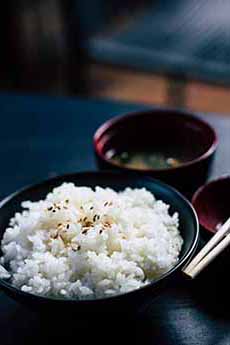Scattered California Roll, California Roll Chirashi Sushi
|
This Scattered California Roll comes under the category of “Why didn’t we think of this?” But we’re thankful that Grace Parisi came up with the idea (more about Grace below). This recipe is in the chirashi sushi category. The name means “scattered sushi” in Japanese, and it’s the easiest sushi to make because, rather than rolling everything nice and tidy in a sheet of seaweed (it takes both practice and seaweed), the ingredients are scattered atop a bowl of rice. Grace combined the idea with grain bowls, and you can substitute your grain of choice for the rice. Wine pairing: The flavors of toasted sesame seeds, seasoned sushi rice, and sweet crab pair well with a crisp, aromatic Austrian Riesling. > Check out the different types of sushi and sashimi in our Sushi Glossary. > The history of sushi This recipe is made with fresh Dungeness crabmeat, but if you can’t get it, substitute one whole bairdi crab cluster (1 body, 4 legs, 1 claw), a type of snow crab. Other options: canned lump crabmeat or crab stick (the different types of crabmeat). Prep time is 30 minutes. 1. MAKE the rice. In a small bowl, combine 2 tablespoons of the rice vinegar with the sugar and ½ teaspoon salt, stirring until dissolved. Set aside. 2. COMBINE the rice with 2 cups of water in a medium saucepan, and bring to a boil over high heat, Reduce the heat to low, cover, and cook until the liquid is absorbed, about 15 minutes. Let the pot sit off the heat, covered, for 10 minutes. 3. SPREAD the rice in a large shallow bowl or on a baking sheet and toss with the reserved sweetened vinegar. Refrigerate briefly until cool. Meanwhile… 4. STEAM the crab. Fill a large skillet with 1 inch of water and bring to a boil over high heat. Add the crab, cover, and steam for 2 to 3 minutes, until just heated through. Remove the meat and break it into 1-inch pieces. You can save shells for stock (stick them in the freezer for future use). 5. PREPARE the dressing. In a small bowl, combine 2 tablespoons of rice vinegar with the soy sauce, oil, ginger, and wasabi paste. Season with salt. 6. ASSEMBLE AND SERVE. Add the radishes, scallions, and cucumbers to the rice, pour the dressing over them, and toss gently to combine. Fold in the crab and spoon the mixture into bowls. Garnish with the avocado, sesame seeds, and shredded nori just before serving. You can wrap any leftover crab, rice, and avocado in green leaf or butter lettuce leaves for a light lunch or snack. Japanese rice, the rice served at every Japanese meal, is a cultivar of Japonica (a.k.a. sinica) rice. It is one of the two major domestic types of Asian rice varieties*. The plump, short grains have a characteristic sticky, firm texture and are slightly sweet. When cooked, they are sticky enough to easily be picked up with chopsticks. (Here’s more about Japanese rice.) Sushi rice is made by seasoning this Japanese short-grain rice with a mixture of rice vinegar (a mild form of vinegar), sugar, salt, and often kombu (kelp). These seasonings impart a balance of sweet, salty, and sour taste flavors that pairs so well with the raw fish. The term sushi means vinegared rice: su = vinegar, shi = rice. Sitka Salmon Shares’ Culinary Director Grace Parisi is a cook, writer and cookbook author. Formerly the Senior Test Kitchen Editor at Food & Wine Magazine and Executive Food Director at TimeInc Books, her work has appeared in Cooking Light, Health, O Magazine, Epicurious, Fitness, Today, Serious Eats, Martha Stewart, and many more. She’s the author of more than 6 books, among them The Portlandia Cookbook and Get Saucy, which was nominated for a James Beard award for Best Single Subject Cookbook. |
|
|
|
________________ *Japonica rice is extensively cultivated and consumed in East Asia, whereas in most other regions of Asia, indica rice is the dominant type of rice. Here’s the difference between the two. In California, rice production is dominated by short and medium-grain japonica varieties, including cultivars developed for the local climate, such as Calrose. A cultivar is a type of plant that people have bred for desired traits (selective breeding). Many cultivars of rice are grown worldwide. The two major subspecies (indica and japonica) have more than 40,000 varieties. Here’s a small list of them. †Pickled ginger recipe: If you can’t find pickled ginger in the Asian products aisle of your supermarket or a local Asian grocer, make your own. Use 1 teaspoon each grated fresh ginger, rice vinegar, and sugar. Allow the flavors to meld for an hour or more.
|
||




